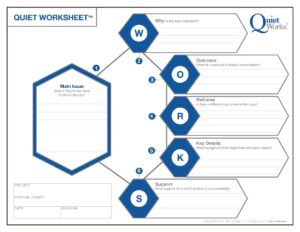

Quiet Preparation: A Seller’s Advantage
For salespeople, time for quiet preparation before each call or meeting may seem like a luxury. But, in an economy marked by inflation, fluctuating markets, the threat of new tariffs, and widespread uncertainty about spending, the stakes for every sales conversation are high. Potential clients are more cautious. When considering a purchase, they’re considering costs for sure. But they’re also making a calculated decision about trust, value, and long-term partnership. In this environment, being seen as a vendor won’t get you very far. You must become an advocate—an ambassador for their success.
As the founder of The BRIEF Lab and the Quiet Workplace, I’ve been in too many sales conversations to count. And I know the biggest advantage in sales comes before the conversation even begins. That’s the heart of the Quiet Selling course: Purposeful quiet time to think, plan, and empathize with your customer long before a word is spoken.
Purposeful quiet time isn’t passive or idle—it’s intensely active. It gives you the space to deeply consider your customer’s world: their pressures, ambitions, and hidden concerns. It allows you to anticipate their needs without making assumptions. Quiet time helps you show up not with a rehearsed pitch, but with real curiosity, empathy, and focus. Instead of rushing to get through your slides, you’re prepared to open a genuine conversation—one where the customer feels truly heard and understood. In a world where everyone is trying to be the loudest voice in the room, silence and preparation make you stand out.
A New POV: Preparation Is an Act of Respect
When you prepare thoughtfully for a customer conversation, you’re not just getting your facts straight. You’re showing respect for the customer’s time, their business, and their goals. Preparation shifts the focus from “what I want to say” to “what they need to share and hear.”
It’s a profound shift—and it’s rare. Buyers consistently report that salespeople are too focused on their own products and services, rather than understanding the unique context of the customer.
This failure to prepare doesn’t just slow down deals—it erodes trust. If you aren’t prepared, the customer assumes you don’t value their business enough to do the homework. In contrast, when you invest quiet time upfront, you position yourself as a trusted partner, not just another vendor.
Takeaway: If most sellers aren’t adequately preparing, quiet preparation instantly becomes your competitive advantage.

How Quiet Preparation Transforms Sales Conversations
The Quiet Selling course emphasizes preparation that goes beyond memorizing talking points. It involves:
- Strategic Reflection: Spending time considering the customer’s current state, challenges, and goals.
- Using the Right Tools: Leveraging resources like the Quiet Worksheet, DRAFT Card, and BRIEF Map to structure your thinking.
- Clarifying Intentions: Knowing what you want to learn in the meeting, not just what you want to say.
- Planning to Listen: Preparing key open-ended questions that invite deeper conversation, not scripted monologues.
When you engage in this kind of preparation, you walk into meetings with confidence and focus. Rather than improvising or defaulting to a sales script, you’re grounded in the customer’s world—ready to meet them where they are. Sales success, as reported by LinkedIn, is directly linked to higher close rates: Top performers don’t actually spend more time selling. 76% of top performers say they “always” conduct research on their buyers before reaching out, compared to just 38% of those who met target.
This level of preparation also enables you to ask better, more relevant questions—questions that open doors to conversations your competitors might never reach. You’re able to uncover insights others might miss simply because you’re not rushing to “pitch.” And most importantly, preparation builds credibility and trust faster. Customers can sense when someone has done the work—and they reward that attention with deeper engagement and loyalty.
A Quick Checklist: Quiet Preparation Before Every Meeting
Before your next client conversation, take 10 minutes of silent preparation to ask yourself:
- What do I already know about their world? Spend time reviewing any public information, previous conversations, or internal notes you have about the customer. Understanding their market position, recent challenges, and strategic initiatives gives you a richer foundation for the conversation.
- What assumptions should I question? It’s easy to walk into a meeting with preconceived notions based on limited information. Challenge your own assumptions and be open to learning something new. A fresh perspective can often uncover opportunities you might have overlooked.
- What 2-3 open-ended questions will help me learn more? Prepare thoughtful, open-ended questions that encourage the customer to elaborate on their needs and challenges. Instead of “Are you looking for X solution?” ask “What are the biggest challenges you’re facing right now in X area?”
- What signals will show that the conversation is on track? Identify specific verbal and non-verbal cues—such as the customer leaning forward, asking you questions, or volunteering deeper insights—that indicate engagement. Being attentive to these signals allows you to adjust your approach in real time.
- How will I create space for them to talk more than I do? Plan to use intentional pauses, active listening techniques, and fewer interruptions. Aim for the customer to speak at least 60% of the time, creating a conversation that feels collaborative rather than transactional.
Small habits like this, practiced consistently, lead to dramatically better outcomes.
Why Quiet Works
Quiet preparation isn’t just a “nice to have”—it’s a professional advantage. It’s the foundation of everything I teach in Quiet Selling, based on the principles outlined in my book Quiet Works: Making Silence the Secret Ingredient of the Workday.
In a world drowning in noise, preparation in silence helps you connect, listen, and lead in a way that’s increasingly rare—and incredibly valuable.
Ready to sell smarter by saying less? Explore Quiet Selling and give your customers—and yourself—the quiet advantage.




